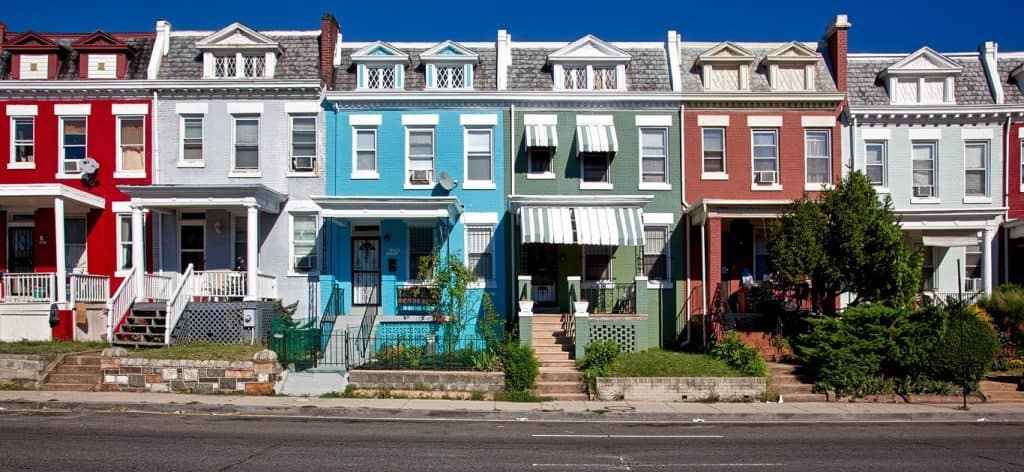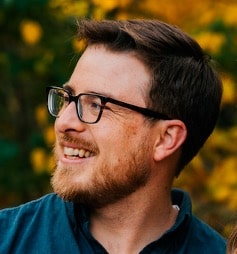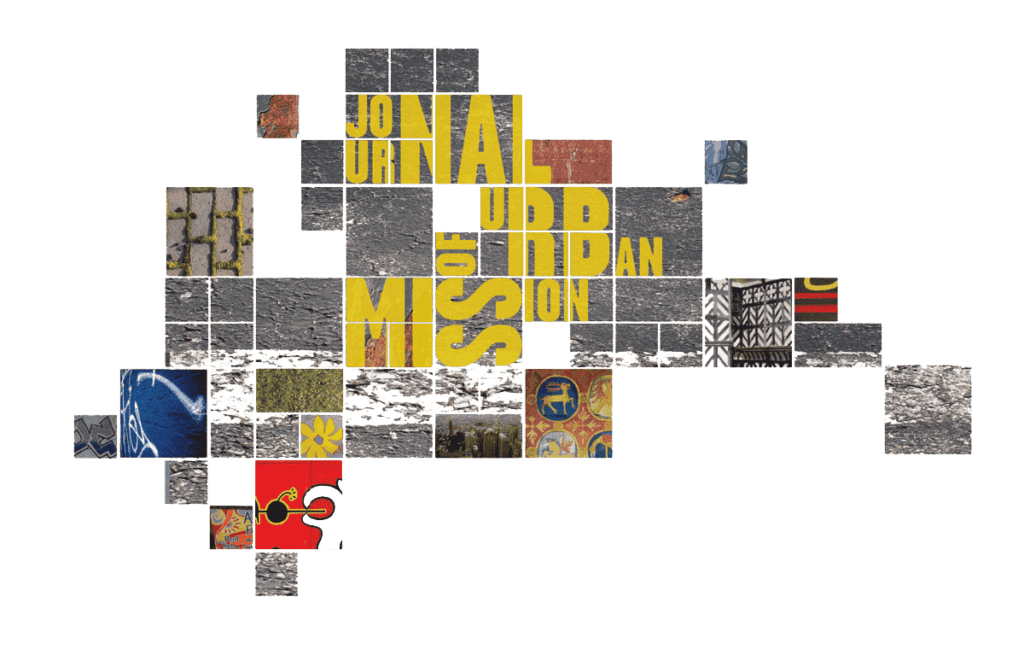What would it mean for the church to intercept the becoming of cities and turn them toward the joy of communion? How might this alternative trajectory in the spiritual-material life of cities interact with ecological systems to cultivate shared wellbeing for all members of creation? Could the urban minister–as community organizer, community developer, prophetic dreamer and spiritual director–theologically imagine and weave together alternatives to social structures that have sought to “seek and kill and destroy?” And if the destabilization of natural systems and undoing of this planet’s wellbeing is in some manner linked to the production of Black, Indigenous, and other peoples of color as permanent underclasses, then how can urban ministers integrate the tasks of undoing these harms?
In 2011, faith-rooted organizers gathered a dozen leaders from churches and synagogues in Washington D.C. who were members of the Washington Interfaith Network (WIN). They met to discuss common needs. Placing private struggles on the table, however mundane, opened a shared discovery: on the heels of the Great Recession electricity prices had ballooned bills higher than minister salaries. Good news has often been most recognizable against the backdrop of shared brokenness. Weakness is strength, writes the Apostle. As organizers, we might put flesh on that paradoxical claim by pointing out how weakness can become strength when we choose to enter the solidarity of community precisely at sites of weakness. It is through uniting isolated pieces into a larger body that we find ourselves gaining new life. Once organized we find an ability to act together in new ways, to have power flowing from relationship for the sake of the common good.

A plan was devised to support these dozen churches in pooling their purchasing power to negotiate a group electricity contract. A year later, the group had saved $100,000. Today, that dozen is joined by over one hundred and sixty other congregations, nonprofits, schools, and businesses in the Greater D.C. area that collaborate on group purchases in fourteen services areas needed by any organization with a building: from janitorial to trash to solar system development. Over the past three years these D.C. institutions were joined by three hundred institutions in Connecticut, Massachusetts, Ohio, and Illinois–the vast majority of which are urban churches. Together they comprise a cooperative owned and led by the participating institutions called the Community Purchasing Alliance (CPA) that uses purchasing power to support their own needs and as a means to pursue racial and environmental justice.
This paper offers CPA as a case study in resistance to what we will call “plantation economics” and a model for developing relationships, institutions, and practices that center mutuality, dignity, and equity. This cooperative of community institutions offers a vehicle for influencing the complex systems of cities and ecosystems, thus allowing churches to simultaneously practice an ethic of communion, heal ecological harms, repair racial injustice, and cultivate shalom.
From Plantation to Shalom Economies
In an interdisciplinary article by Moore, Allewaert, Gómez, and Mitman, the authors contrast two common descriptors for our era of climate change and catastrophe—the anthropocene and The Great Acceleration–with a proposal that re-centers the continuity of ecological violence with the economic and cultural forces of white supremacy and colonialism.1 The “anthropocene,” they write, places attention on the historically unique emergence of humans as an animal pushing planetary systems out of equilibrium into new, chaotic states–and the tipping point crossed wherein restoration is now impossible without human-directed action.2 A second term coined by climate scientists was the “Great Acceleration,” referring to “a host of global indicators [which] suggest that since 1950 we have entered a period where rates of human activity, including population growth, energy use, and fossil fuel and fertilizer consumption, have so rapidly increased that they are altering Earth systems in profound ways.”3
Even as these names rightly identify human activity and, in particular, economic and technological choices increasingly made since the Industrial Revolution as driving sources of ecological degradation, they elide who sat at the helm of these social forces and how they are linked to older legacies. “What the Anthropocene label masks,” writes Moore and company, “and what the litany of graphs documenting the Great Acceleration hide, is a history of racial oppression and violence, along with wealth inequality, that has built and sustained engines of economic growth and consumption over the last four centuries.”4 To resurface the economic machinery of white supremacy and colonialism as a relationship that linked the exploitation of racialized bodies to extraction from commodified lands, they urge readers to consider our age as being better described the “Plantationocene.”
The plantation… was a ‘synthesis of field and factory,’ an agro-industrial system of enterprise integral to the historic rise and growth of capitalism. The plantation and its accompanying rearrangements of life are produced through processes of land alienation, labor extraction, and racialized violence. As such, the plantation marks an important site to consider the ways in which land, labor, and capital have been ordered to profit some, while imperiling the lives and livelihoods of others, across the globe.5
For the authors, designating this era the Plantationocene helps us face the racialized socioeconomic forces at work behind “rapid climate change, accelerated species extinction, and growing wealth disparity more precarious for some human and nonhuman beings than others.” Reading our times as Plantationocene thus provides a hermeneutic key for interpreting the links between climate change, extractive and racialized economic structures, and the disproportionate suffering from environmental harm experienced by peoples of color, the poor, and the Global South.
As plantations colonized new landscapes, they reconfigured legal, ecological, economic, social, and affective relationships around the white man’s body. Edward Baptist’s remarkable book The Half Has Never Been Told includes a series of maps depicting the coproduction of slave society with the conversion of vast stretches of land from ecologically diverse watersheds to cotton monocrops.6



Plantation economies are always also plantation ecologies. Webs of reconstrued relationships spread beyond these maps. They reached north to banks in New York and Boston that financed plantation agribusiness, issued loans and insurance for human property, and swapped cotton futures. They extended across the Atlantic in the triangular trade that moved bodies, goods, money, militaries, and all manner of creatures around and between empires, with slavery fueling the Industrial Revolution in the white North Atlantic.7 These motions laid operative and ideological foundations for present social systems’ reproduction of racialized and ecological violence.
If the plantation is the model on which modern structures of relationship have been built, then the white male Master has been the image of who we must become to rule over these relations. Willie Jennings gave theological voice to the spread of this warped formation:
Plantations were also about cultivating leadership and establishing a social order necessary for promoting commerce and civilization. Slavery taught us how to build. It taught us how to build a home, how to build a church, how to build a school, and how to build a person. Slavery took a theological truth—that the creature builds—gave thanks for it, broke it into pieces, and forced us to eat the stones.8
The Master distorts creation and the work of creating by commodifying land, creatures, and human bodies. The Master to created-Subject-turned-commodity relationship is expressed in two phases. The first is possession for use. The second is discarding the used-up good. People, places, and things can all meet these fates in the plantation economy. This linear “commodify-possess-use-discard” process disrupts the regenerative cycles of creation. Sacred life is turned toward death.
Lutheran theologian Cynthia Moe-Lobeda has argued that love, understood in its proper magnitude, is a virtue whose expression must by nature take structural form. “Love that seeks justice is the counterpoint of structural evil… love becomes not only an interpersonal vocation but also an economic-ecological vocation.”9 Shalom remains among the most evocative biblical language for imagining a world of relationships cultivated through and for love. Not a static condition, shalom is a living dynamic of connection between people, God, and creation where justice opens a peaceable community in which all can thrive. According to Keetoowah Cherokee theologian Randy Woodley, “Shalom is meant to be both personal (emphasizing our relationships with others) and structural (replacing systems where shalom has been broken or which produce broken shalom, such as war- or greed-driven economic systems). In shalom, the old structures and systems are replaced with new structures and new systems.”10 When shalom takes flesh it is the anti-plantation.
In direct opposition to colonial capitalism’s destruction of people and planet, a movement to develop a radical alternative called the “solidarity economy” has emerged in places used and discarded by plantation masters. The solidarity economy includes a broad set of practices aligned with the values of solidarity, participatory democracy, equity in all dimensions, sustainability, and pluralism.11 The New Economy Coalition’s website describes the solidarity economy as “growing out of social movements in Latin America and the Global South, [which] provides real alternatives to capitalism, where communities govern themselves through participatory democracy, cooperative and public ownership, and a culture of solidarity and respect for the earth.” The solidarity economy includes various institutional forms of cooperatives, community financial institutions like credit unions, and community land trusts while also resurfacing the value of non-self-interest-centered practices like gifts and mutual aid. In its exchange of hierarchical domination for cooperative mutuality, the solidarity economy offers one model for repudiating the white master archetype and enacting “love made public” (to paraphrase Cornel West). Christians longing for shalom may discover deep resonance with the vision and practices swelling through this movement, and find many opportunities to contribute to its theory and practice.
The City as a Nested Complex Adaptive System of Systems
Open questions remain. What do the Plantationocene and the solidarity economy have to do with the city or the task of the urban minister? Where and how does the urban church link to this work? To begin an answer to these questions, let us return to the city itself. Following a growing body of literature in the fields of geography, urban studies, sociology, and urban planning, urban ministry will benefit by recognizing cities as a unique type of “complex adaptive system” which is a spatial, material, and social set of self-organizing interrelationships.12
Counterposed to an object (a rock) and a collection (a pile of rocks), a system (geological cycles) is “an interconnected set of elements that is coherently organized in a way that achieves something… consist[ing] of three kinds of things: elements, interconnections, and a function or purpose.”13 Complex adaptive systems (CAS), beyond simple systems like machines, are composed of vast numbers of these three general systems elements, whose interactions are not fully governable and give rise to unpredicted, emergent characteristics. CAS studies were originally confined to organic, living systems and work in the fields of biology and ecology until physicists noticed the emergent characteristics of other physical systems in the mid-twentieth century. Toby Hemmenway, summarizing the properties of CAS, says they “contain many autonomous parts, they respond to changes via feedback, and they form self-organizing, self-maintaining assemblages that display emergent properties.”14
What would it mean for the telos of a city to shift from establishing themselves as sites of power from which an empire can extract resources from creation toward a telos aligned with the eschatological vision of shalom?
We should pause to take theological note of the third system’s element: “function or purpose.” Like the human body’s effort to maintain heat rates or body temperature, all systems possess a teleological dynamic in their pursuit of some state of dynamic equilibrium. Many emergent properties of systems come as side-effects from their pursuit of this chief goal. To maintain a healthy internal temperature, bodies sweat. Transformation comes to systems when this telos–this end or good–is changed, thus changing the goal which all of its elements and interconnections must pursue. What end have our cities, as complex adaptive systems, pursued? What would it mean for the telos of a city to shift from establishing themselves as sites of power from which an empire can extract resources from creation toward a telos aligned with the eschatological vision of shalom?
Two further dimensions of this systems view of cities are relevant to our case study. First, urban complex adaptive systems are themselves composed of innumerable sub-systems. The systems theory language for this composition is “nested systems.” Bodies are interconnected systems of organs which are themselves made up of cellular-level systems. Jeffrey Johnson paints an evocative picture:
It is clear that cities have subsystems. Examples include their housing, transport, garbage, water, education, and health subsystems. These subsystems interact, as in the case of the transport subsystem enabling people to leave the housing system to visit relatives in the health subsystem. The subsystems themselves have subsystems. For example, the transport subsystem may have a metro subsystem, a bus subsystem, a car subsystem, a truck subsystem, a pedestrian subsystem, bicycle subsystem and even an airport subsystem. These subsystems also interact with each other, for example as people make multimodal trips, and as different modes compete for road space and passengers. Somewhere against this mix of systems of systems of systems there are business subsystems, family subsystems, political subsystem…. Any of these subsystems may interact with any of the others, and the dynamics of the whole emerge from the many interactions between the many parts.15
Johnson offers a simple model for visualizing a city’s nested systems:16
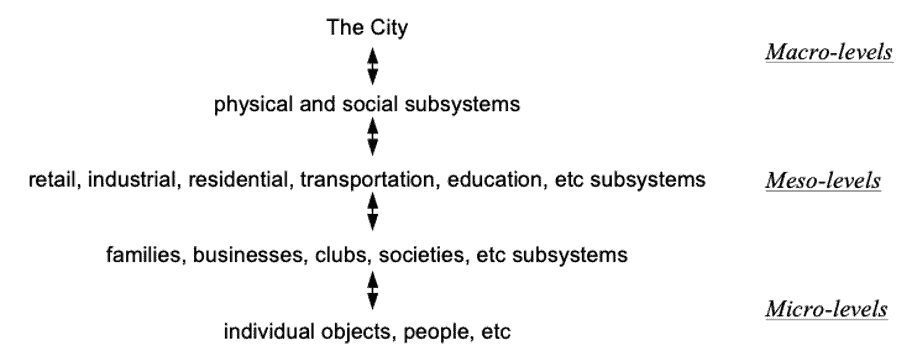
Religious institutions operate on a number of these levels. Historic church buildings form distinctive nodes in the physical built environment itself, often establishing the visual and spatial centering point of a neighborhood.17 Denominational structures and other networks of religious life–including the significant presence of faith-based nonprofits, social service agencies, and other institutions in many cities–operate at higher meso-levels, while individual local churches and other houses of worship might be situated alongside “families, businesses, clubs, etc.” The Church and churches (big and little “c”) are thus themselves discrete systems operating at and interconnected through every level of urban life and form.
Finally, this systems view of cities–and systems view of the Body of Christ as she is incarnated in the world today–opens a door through which we find a nuanced picture of our connections to other socio-environmental systems and potentials for serving as agents of change within them. If cities, and Christian institutions, can accurately be described as unique types of complex adaptive systems, they are not unique in this broader designation. The theologically attuned political philosopher William Connelly scopes out to a wider lens when he rightly recognizes how,
the planet, and indeed the cosmos, is replete with self-organizing, spatiotemporal systems flowing at different speeds, levels of sophistication, and degrees of self-sustaining power. These impersonal systems are open to some degree and never in perfect equilibrium; they interact, with each having a degree of entanglement with several others. They interact in two senses of the word: each impinges upon others, and some may become partially infused into others.18
A diverse field of physical, communal, economic, political, cultural, ideological, and other social systems are continuously interacting and mutually influencing one another in and between cities. These social relationships are fully in and of creation, entangled with water and carbon cycles, seasonal cycles, ecosystems, and bioregions. Relationality is indeed at the very center of how God designed the cosmos–with all the freedom, risk, responsibility, and unpredictability implicit in it. In this view, the peace of a city is, properly speaking, an emergent property. It is not something one can produce directly. Rather shalom is a dynamic state that grows from complex relational networks of interacting social, environmental, and spiritual systems as their telos turns toward justice and the common good. It is also precisely these entangled relationships that offer urban ministers leverage for transforming systems from death to life, from the plantation to shalom.
Shalom is a dynamic state that grows from complex relational networks of interacting social, environmental, and spiritual systems as their telos turns toward justice and the common good.
Churches Cooperating in the City Among Creation
Churches and other faith-based institutions are, in Connolly’s terms, “impinged and infused” with major subsystems of urban economies, built environments, and natural environmentals. Simply to maintain and operate their buildings, churches are linked by contracts to global energy markets (electricity, natural gas), hydrological systems (water, landscaping), global corporations (insurance, banking, consumer goods and waste industries), waste and carbon cycles (trash, recycling, and compost), and the small business sector (cleaners, roofers, HVAC technicians, masons, etc.). Money flows across racial, geographic, religious, and class barriers through these contracts. Often those flows reinforce inequality, pollution, and extraction. But it could be otherwise. If the extraction and racialized hierarchies of plantations are common sense to the powers and principalities of this world, then we are invited by the Spirit to turn toward the gospel of Jesus which draws us together at the communion table where we find union through mutual need, and the grace to practice the rhythms of shalom. Alone, however, a single church lacks adequate power to influence these systems–and often lacks the capacity or prophetic imagination to act with intention in these relationships.
This is systems change work. And it must be woven together on several levels. The Anyi Institute proposes theories of change should connect three modes of action to form what they term a “movement ecology.” These three segments are personal transformation (spiritual growth, values and ideological shifts, personal practices, interpersonal relationships, etc.), changing dominant institutions (shifts in government and corporate policies and actions through advocacy, activism, organizing, and “inside game” tactics), and the building of alternatives (creating new institutions that embody the values we want to see in the world, such as the solidarity economy described above).

To put it colloquially: we need to “be the change” (Personal Transformation), we need to demand the world we want from the powers that be (Changing Dominant Institutions), and we need to find ways to build the world as it should be ourselves (Alternatives).19
The Community Purchasing Alliance is one such alternative. It enables churches to enter into a community that practices economic solidarity rooted in common needs and a shared vision of the common good. It is a vehicle for shifting the functions of faith-institutions, in partnership with other community institutions, from plantation to shalom economics. By intentionally influencing interconnections with the larger systems described above, CPA enables its members to become a force for broader socio-environmental transformation, and a catalyst for the solidarity economy. In each of its institutional structures and business operations it asks the question all pursuers of shalom must ask: how can this be used to form life-giving relationships in which all can thrive?
Let us briefly cover the basics of how the business works. CPA is a group purchasing organization cooperatively owned by the institutions who use its services. These institutions are typically nonprofits–a majority are houses of worship–who own and manage facilities, and thus have similar maintenance and operations costs. CPA organizes institutions around these common needs to facilitate group purchasing; run competitive Requests for Proposals from selected business vendors; provide a higher degree of research, analysis, expertise and insight into choices than institutions could do on their own; and bring a thick set of values around community, equity, racial justice, environmental sustainability, and worker’s rights to the assessment of ideal contract opportunities. The following diagram helps illustrate CPA’s model:
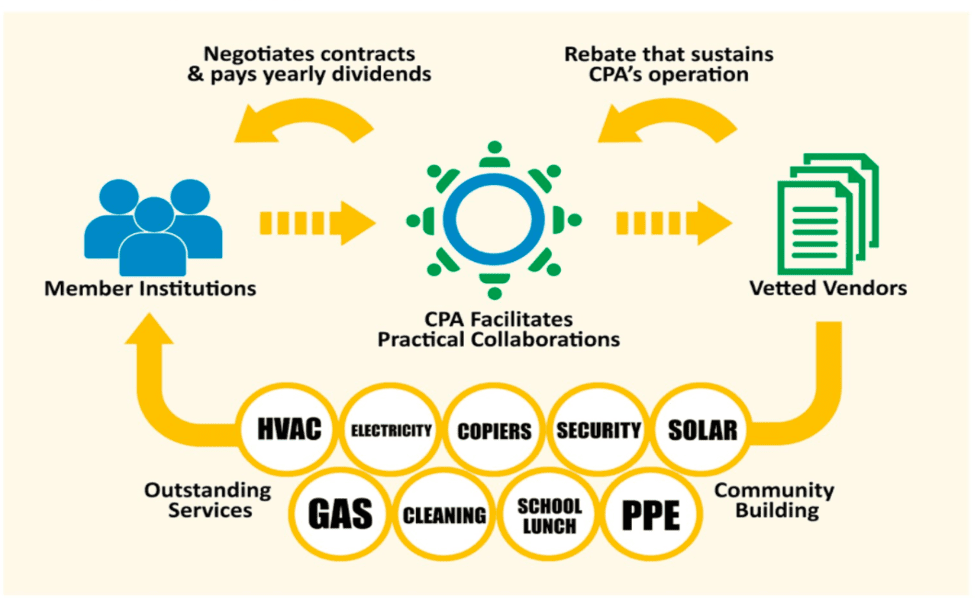
By organizing hundreds of institutions to act together around these basic services, CPA empowers small institutions to form a collective that brings its values to bear on urban, economic, and ecology systems at scale. The impacts have been substantial. In 2021, over twenty-one million dollars of purchasing was managed by the cooperative. In last year’s group electricity purchases, according to CPA’s annual report, “61 organizations chose 100% Green E-Certified Renewable Energy Credits, supporting almost 30,000,000 kWh of renewable energy generation a year.” Renewable Energy Credits (RECs) are a primary source of financing for the development of new renewable energy production, particularly wind farms. The cooperative has also overseen solar developments for forty organizations in Washington D.C. that produce 5.5 Megawatts of electricity each year. Many of CPA’s members are motivated to use their purchasing power to repair racial wealth inequality. For them, “Each transaction is a chance to ask, ‘how do our business decisions impact our community?’ Together more than 50% of the Co-op contract spend stays with local small businesses, including more than $13 million with DC-based minority-owned businesses over the last three years.” CPA is also exploring partnerships with worker-owned cooperatives, among other means of support for the solidarity economy.
These impacts are undergirded by a deeper reordering of relationships within the organization itself. In place of white supremacist hierarchies, cooperative ownership and management structures offer concrete means to centers of community, democracy, mutuality, and power sharing. CPA is collectively owned by the institutions who use its services. In place of traditional capital supremacy where those who bring the most money hold the most power, cooperatives practice “one-member, one-vote” governance, meaning each institution, no matter how large or how small its equity investment, has the same number of votes for electing the board and affecting organizational strategy. Though CPA does not at this time offer ownership options to its employees, the staff practices a highly democratic and shared-form of leadership and decision-making.20 Such practices enrich the authenticity of its efforts to cultivate deep relationships. These are transformational shifts that go to the very roots of our intertwined crises of racial injustice and climate catastrophe–they reject the logics of plantation masters and offer a vision for a social order of relationships rooted in equity, inclusion, and care.
Toward Communion
Urban ministry has, from its inception, taken the sociological milieu of the city seriously. It attends to the spirit of a place and studies the historical, structural, psychological, and spiritual forces forming and deforming neighborhoods and lives. As sea walls are crested near low-lying slums, as tree denuded neighborhoods swell with heat, as cancer rates in Black and Brown neighborhoods skyrocket from the polluters who cluster around them, and as the poor remain stuck in their paths of increasingly ferocious storms, urban ministers have been forcefully reminded that the concrete islands around us are less isolated from the natural world than they often feel. Hope for the future will rely on clearly identifying the systems flowing around and through us, finding leverage points from which to make change, following the leadership of those most marginalized and impacted, and transforming systems through love for shalom. The Community Purchasing Alliance cooperative is one model that can awaken our imagination to new possibilities. It remembers Jenning’s theological fundamental that “the creature builds” and seeks to build in the image of our Creator who draws creation toward communion.
Notes
1 Moore et al., “Plantation Legacies,” Edge Effects, The Plantationocene Series: Plantation Worlds, Past and Present. Updated May 15, 2021. https://edgeeffects.net/plantation-legacies-plantationocene/
2 Paul Crutzen and Eugene Stoermer, “The ‘Anthropocene’ (2000).” The Future of Nature: Documents of Global Change, ed. Libby Robin, Sverker Sörlin and Paul Warde (New Haven: Yale University Press, 2013), 479-490.
3 Moore et al.
4 Ibid.
5 Ibid.
6 Edward Baptist, The Half Has Never Been Told: Slavery and the Making of American Capitalism (New York: Basic Books, 2014), x-xii. Baptist parallels these two map series with a third: showing how the successive expropriation of land from Indigenous communities preceded plantation economies and ecologies.
7 Eric Williams, Capitalism & Slavery, 3rd ed. New York: Basic Books, 2014.
8 Willie James Jennings, After Whiteness: An Education in Belonging (Grand Rapids, MI: Eerdmans, 2020), 83.
9 Cynthia Moe-Lobeda, Resisting Structural Evil: Love as Ecological-Economic Vocation (Minneapolis, MN: Fortress Press, 2013), xviii.
10 Randy Woodley, Shalom and the Community of Creation: An Indigenous Vision (Grand Rapids, MI: Eerdmans, 2012), 14.
11 Emily Kawano and Julie Matthaei, “System Change: A Basic Primer to the Solidarity Economy,” Nonprofit Quarterly, July 8 2020. https://nonprofitquarterly.org/system-change-a-basic-primer-to-the-solidarity-economy/
12 See for example: Roger White, Guy Engelen, and Inge Uljee, Modeling Cities as Self-Organizing Systems: From Theory to Planning Applications (Cambridge, MA: The MIT Press, 2015), and Juval Portugali, Han Meyer, Egbert Stock, and Skim Tan, eds. Complexity Theories of Cities Have Come of Age: An Overview with Implications to Planning and Design (New York: Spring, 2012).
13 Donella Meadows, Thinking in Systems: A Primer (White River Junction, VT: Chelsea Green Publishing, 2008), 11. Emphasis original.
14 Toby Hemmenway, The Permaculture City: Regenerative Design for Urban, Suburban, and Town Resilience (White River Junction, VT: Chelsea Green Publishing, 2015), 12.
15 Jeffrey Johnson, “Cities: Systems of Systems of Systems,” in Portugali et al., Complexity Theories of Cities, 153.
16 Ibid., 154.
17 Kevin Lynch, The Image of the City (Cambridge, MA: The MIT Press, 1960).
18 William Connolly, The Fragility of Things: Self-Organizing Processes, Neoliberal Fantasies, and Democratic Activism (Durham, NC: Duke University Press), 81.
19 Anyi Institution Website, “Movement Ecology,” https://ayni.institute/movementecology/
20 CPA has adopted an operational structure called Sociocracy. This closely mirrors the Catholic Social Teaching principle of subsidiarity in which power and decision-making is pressed downward as close to the site of life and action as possible.
